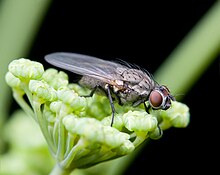
Back ذباب الأزهار Arabic ذباب الازهار ARZ Antòmids Catalan Anthomyiidae CEB Blumenfliegen German Antomiedoj Esperanto Anthomyiidae Spanish مگسهای گل Persian Juurikärpäset Finnish Anthomyiidae French
This article needs additional citations for verification. (January 2021) |
| Anthomyiidae | |
|---|---|

| |
| Root-maggot fly Hydrophoria linogrisea | |
| Scientific classification | |
| Domain: | Eukaryota |
| Kingdom: | Animalia |
| Phylum: | Arthropoda |
| Class: | Insecta |
| Order: | Diptera |
| (unranked): | Eremoneura |
| (unranked): | Cyclorrhapha |
| Section: | Schizophora |
| Subsection: | Calyptratae |
| Superfamily: | Muscoidea |
| Family: | Anthomyiidae Robineau-Desvoidy, 1830[1] |
| Subfamilies | |


The Anthomyiidae are a large and diverse family of Muscoidea flies. Most look rather like small houseflies. Most species are drab grey to black. Many Pegomya are yellow, and some members of the genera Anthomyia and Eutrichota are patterned in black-and-white or black-and-silvery-grey. Most are difficult to identify, apart from a few groups such as the kelp flies that are conspicuous on beaches.
The name Anthomyiidae was derived from Greek anthos (flower) plus myia (a fly).
Some species are commonly called "root-maggots", as the larvae are found in the stems and roots of various plants. As larvae, some also feed on decaying plant material. The well-known grey "seaweed flies" or "kelp flies" (Fucellia) are examples.[2] Others are scavengers in such places as birds' nests; yet other species are leaf miners; the family also includes inquilines, commensals, and parasitic larvae.
Some species in the family are significant agricultural pests,[3] particularly some from the genus Delia, which includes the onion fly (D. antiqua), the wheat bulb fly (D. coarctata), the turnip root fly (D. floralis), the seedcorn maggot (D. platura), and the cabbage root fly (D. radicum).
In some contexts, like mountain environments, the adults can be common flower visitors,[4] also being involved in pollination.[5]
- ^ Robineau-Desvoidy, André Jean Baptiste (1830). "Essai sur les myodaires". Mémoires presentés à l'Institut des Sciences, Lettres et Arts, par divers savants et lus dans ses assemblées: Sciences, Mathématiques et Physique. 2 (2): 1–813. Retrieved 15 July 2018.
- ^ Alan Weaving; Mike Picker; Griffiths, Charles Llewellyn (2003). Field Guide to Insects of South Africa. New Holland Publishers, Ltd. ISBN 1-86872-713-0.
- ^ Finch, Stan (1989). "Ecological Considerations in the Management of Delia Pest Species in Vegetable Crops". Annual Review of Entomology. 34: 117–137. doi:10.1146/annurev.en.34.010189.001001.
- ^ Bonelli, Marco; Eustacchio, Elena; Avesani, Daniele; Michelsen, Verner; Falaschi, Mattia; Caccianiga, Marco; Gobbi, Mauro; Casartelli, Morena (2022). "The Early Season Community of Flower-Visiting Arthropods in a High-Altitude Alpine Environment". Insects. 13 (4): 393. doi:10.3390/insects13040393. PMC 9032982. PMID 35447835.
- ^ Wagner, Johanna; Lechleitner, Martin; Hosp, Daniela (2016). "Pollen limitation is not the rule in nival plants: A study from the European Central Alps". American Journal of Botany. 103 (3): 375–387. doi:10.3732/ajb.1500214. PMID 26933013.